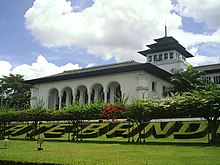Gedung Sate
| Gedung Sate | |
|---|---|
 A view of Gedung Sate | |
 | |
| Former names | Departement van Gouvernements Bedrijven (GB) building |
| General information | |
| Architectural style | New Indies Style, Dutch Rationalism, Sundanese style |
| Location | Bandung, Indonesia |
| Address | Jalan Diponegoro No. 22 |
| Coordinates | 6°54′09″S 107°37′07″E / 6.902459°S 107.618730°E |
| Construction started | 27 July 1920 |
| Completed | September 1924 |
| Owner | Government of West Java |
| Technical details | |
| Floor count | 3 |
| Floor area | 27,990.859 m2 |
| Design and construction | |
| Architect(s) | J.Gerber |
| Other designers | Eh. De Roo, G. Hendriks |

Gedung Sate is a public building in Bandung, West Java, Indonesia. It was designed according to a neoclassical design incorporating native Indonesian elements (such as Hindu-Buddhist elements) by Dutch architect J. Gerber to be the seat of the Dutch East Indies department of State Owned Enterprises (Departement van Gouvernmentsbedrijven, literally "Department of Government Industries"); the building was completed in 1924. Today, the building serves as the seat of the governor of West Java,[1] and also a museum.[2]
Its common name, Gedung sate, is a nickname that translates literally from Indonesian to 'satay building', which is a reference to the shape of the building's central pinnacle - which resemble the shape of one of the Indonesian traditional dish called satay.[1] The central pinnacle consists of six spheres that represent the six million guilders funded to the construction of the building.[3]
See also
References
- ^ a b "History of Gedung Sate". Museum Gedung Sate. Retrieved 2018-09-08.
- ^ "Museum Gedung Sate". museumgedungsate.org. Retrieved 2018-09-08.
- ^ "Gedung Sate". iciebp.conference.upi.edu. Archived from the original on 2022-06-22. Retrieved 2021-06-12.
